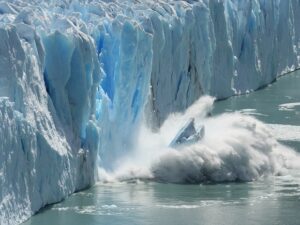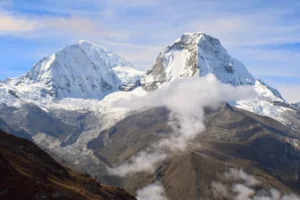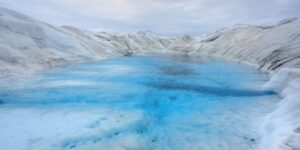
Glaciers across the globe are shrinking at an unprecedented pace, with the Hindu Kush Himalaya (HKH) region witnessing the most dramatic losses, retreating 65% faster in 2011-2020 than in the previous decade, according to a United Nations report released on the World Day for Glaciers.
The Asia-Pacific region, home to some of the world’s highest mountains and vast glacier systems, is one of the most vulnerable to climate change. Spanning five million square kilometers of high-altitude terrain, the HKH region contains nearly 100,000 square kilometers of glaciers, often referred to as the “Third Pole” due to its immense ice reserves outside the Arctic and Antarctic. This region serves as a crucial water source, feeding ten major river systems and sustaining nearly two billion people.
If global temperatures rise by 1.5 to 2 degrees Celsius, glacier volume in the HKH could shrink by 30-50% by 2100. If warming exceeds 2°C, the region may lose nearly half of its glacier volume from 2020 levels. Spanning eight countries Afghanistan, Bangladesh, Bhutan, China, India, Myanmar, Nepal, and Pakistan these mountains are home to 240 million people, with 1.65 billion more downstream relying on their waters for essential needs like drinking water, agriculture, hydropower, and ecosystem stability.
A Global Water Crisis in the Making

The UN World Water Development Report 2025, released on March 21, paints a bleak picture of mountain glaciers worldwide. Projections suggest that if temperatures rise between 1.5°C and 4°C, glaciers could lose 26-41% of their total mass by 2100 compared to 2015 levels.
Michela Miletto, UNESCO WWAP Coordinator, and Richard Connor, Editor-in-Chief says “Mountains worldwide, including those in the tropics and small islands are undergoing unprecedented changes and we all ultimately live downstream”.
A striking example is the rapid disappearance of the Conejeras Glacier in Colombia, which vanished in just a month. In August 2023, the glacier was still visible, covered in snow. By September, a video captured by a mountain guide showed that it had completely disappeared highlighting the speed of glacial retreat.
Melting Glaciers Trigger Natural Disasters

The accelerating glacier melt is leading to catastrophic consequences. Rising temperatures are altering hydrological systems, with studies predicting increased runoff in monsoon-dominated basins. However, the impacts vary by region.
Glacial melt is a key driver of natural disasters particularly Glacial Lake Outburst Floods (GLOFs), which can cause sudden and devastating floods. Since the 1990s, the number and size of glacial lakes have increased significantly, with GLOFs claiming over 12,000 lives in the past 200 years. The HKH region alone has recorded over 7,000 fatalities from such floods in the last 190 years, with the risk expected to triple by the century’s end. “Many consequences will go beyond the limits of adaptation,” warned the report.
Economic and Environmental Fallout
The report also highlighted how climate change is disrupting mountain-based industries. For instance, lithium mining in Bolivia, Argentina, and Chile requires massive water extraction, straining local communities. Producing just one tonne of lithium consumes around 2,000 cubic meters of water, intensifying the crisis.
Similarly hydropower-driven cryptocurrency mining in Central Asia is raising concerns. Hydropower is a dominant industry in mountain regions, but poorly planned small hydropower plants are depleting water resources. In Georgia, some rivers have completely dried up due to excessive hydropower infrastructure.
Climate change is also impacting hydropower generation by accelerating glacier melt shifting rainfall patterns, and increasing evaporation. However, there is no conclusive evidence that global warming will enhance water availability for hydropower. Any short-term boost from glacial melt could be countered by higher evaporation rates. Satellite data already shows a decline in global lake water storage, including artificial reservoirs.
Governance Failures and Funding Gaps
The report stressed that water governance in mountain regions is significantly weaker than in lowland areas. In the HKH, transboundary cooperation remains ineffective, with mutual distrust hampering data sharing.
Report stated “Data and information sharing are crucial for disaster risk reduction such as for GLOFs and river floods. However mistrust between neighboring countries limits the ability to manage water resources efficiently”.
The UN outlined six key actions for the HKH region: strengthening regional cooperation recognizing the needs of mountain communities, accelerating climate action to limit warming to 1.5°C, achieving Sustainable Development Goals, enhancing ecosystem resilience, and promoting data sharing.
To address the crisis report also recommended incentivizing communities that protect crucial watershed areas for hydropower, drinking water, and tourism. However, despite available funding for sustainable development in mountain regions, access to major support programs has been severely limited.
